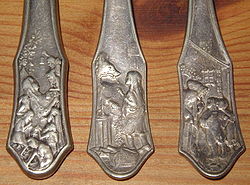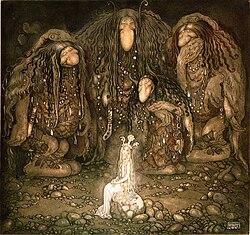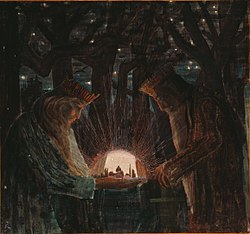Fairy tale
A fairy tale is an English language expression for a kind of short story. It has the same meaning as the French expression conte de fée or Conte merveilleux, the German word Märchen, the Italian fiaba, the Polish baśń, the Russian сказка or the Swedish saga. These stories are not all directly about fairies,[1] but they are different from legends and traditions (which usually say that the stories are true)[2] and directly moral stories.
Fairy tales are usually set during the Middle Ages (but some are more modern) and typically include royalty, knights and fantasy elements such as fairies, goblins, elves, trolls, giants or gnomes and usually magic.
Fairy tales can also mean unusual happiness (for example, the expression "fairy tale ending", meaning a happy ending, even though not all fairy tales have a happy ending).[3] Also, "fairy tale" can simply mean any unbelievable story.
Where demons and witches are seen as real, fairy tales can sometimes be similar to legends, where the story is claimed to be historically true. However, differently from legends and epics, they usually do not specifically mention religion and actual places, people, and events. They also do not say exactly when it happened. Instead, they say that the story happened "once upon a time".[4]
Fairy tales are found in oral form (passed on from mouth to mouth) and in literary form (written down). Fairy tales' histories are hard to find. This is because only written fairy tales can be passed on for a long time. Still, literary works show that there have been fairy tales for thousands of years. Many fairy tales today have are based on very old stories that have appeared, though in different ways, in many different cultures around the world.[5] Fairy tales, and works based on from fairy tales, are still written today.
At first, fairy tales were for both adults and children, but now children are mostly connected with fairy tales. Examples of traditional old fairy tales are Sleeping Beauty, Little Red Riding Hood and "The Three Little Pigs". There can also be new fairy tales written by an author, like The Little Mermaid or Pinocchio. New fairy tales were for example written by Hans Christian Andersen, James Thurber and Oscar Wilde.
Meaning
People do not agree what a fairy tale exactly is.[6] Some argue that a story with fairies or other magical beings in the story would make it a fairy tale. However, others have suggested that the expression began when the French expression conte de fées was being translated (it was first used by Madame D'Aulnoy in 1697).[7] Vladimir Propp criticized the difference between "fairy tales" and "animal tales" in his book Morphology of the Folktale.[8] He said that many stories had both fantastic qualities and animals.[8] He suggested that fairy tales could be recognized by their story, but this has been criticized, because the same stories can be found in stories that are not fairy tales.[9]
In fact, people such as Stith Thompson point out that there are often more talking animals and magic in fairy tales than fairies.[10] However, just because there is a talking animal in a story does not mean that the story is a fairy tale.[11]
Steven Swann Jones said that fairy tales were different from other sorts of folktales because of magic.[12] Davidson and Chaudri say that "transformation (changing)" is the most important part of a fairy tale.[13]
Some like to use the German expression Märchen or "wonder tale"[13] instead of fairy tale. For example, in his 1977 edition of The Folktale, Thompson said that fairy tales were "a tale of some length involving a succession of motifs or episodes. It moves in an unreal world without definite locality or definite creatures and is filled with the marvelous. In this never-never land, humble heroes kill adversaries (enemies), succeed to kingdoms and marry princesses."[14] The characters and motifs of fairy tales are simple: princesses and girls taking care of geese; youngest sons and brave princes; ogres, giants, dragons, and trolls; wicked stepmothers and false heroes; fairy godmothers and other magic helpers, often talking horses, or foxes, or birds; rules, and people breaking rules.[15]
History
Fairy tales were passed down by speaking of it from person to person before writing was developed. Stories were told or acted out dramatically. Because of this, the history of fairy tales is not very clear.[16] The oldest written fairy tales we know are from ancient Egypt, around 1300 BC.[17] There are sometimes fairy tales in written literature in different cultures, such as The Golden Ass, which includes Cupid and Psyche (Roman, 100–200 AD).[18] They show that fairy tales were told from very long ago.
Fairy Tale Media
The European fairy tale Little Red Riding Hood and the Wolf in a painting by Carl Larsson in 1881.
Pages from a printed edition of the 14th-century Chinese "wonder tales" collection Jiandeng Xinhua by Qu You; the collection is considered to be one of the most influential East Asian works of fiction.
Cutlery for children. Detail showing fairy-tale scenes: Snow White, Little Red Riding Hood, Hansel and Gretel.
John Bauer's illustration of trolls and a princess from a collection of Swedish fairy tales
Kings' Fairy Tale, 1909, by Mikalojus Konstantinas Čiurlionis
Beauty and the Beast, illustration by Warwick Goble
References
- ↑ "fairy tale -- Britannica Online Encyclopedia". britannica.com. Retrieved 20 July 2010.
- ↑ Thompson, Stith. Funk & Wagnalls Standard Dictionary of Folklore, Mythology & Legend, 1972 s.v. "Fairy Tale"
- ↑ Merriam-Webster definition of "fairy tale"
- ↑ Catherine Orenstein, Little Red Riding Hood Uncloaked, p. 9. ISBN 0-465-04125-6
- ↑ Gray, Richard. "Fairy tales have ancient origin." Archived 2014-07-17 at the Wayback Machine Telegraph.co.uk. 5 September 2009.
- ↑ Heidi Anne Heiner, "What Is a Fairy Tale? Archived 2010-01-03 at the Wayback Machine"
- ↑ "Les Contes des Fées: The Literary Fairy Tales of France". endicott-studio.com. Retrieved 18 July 2010.
- ↑ 8.0 8.1 Vladimir Propp, Morphology of the Folk Tale, p. 5. ISBN 0-292-78376-0.
- ↑ Steven Swann Jones, The Fairy Tale: The Magic Mirror of Imagination, Twayne Publishers, New York, 1995, p. 15. ISBN 0-8057-0950-9.
- ↑ Stith Thompson, The Folktale, p. 55, University of California Press, Berkeley Los Angeles London, 1977
- ↑ J. R. R. Tolkien, "On Fairy-Stories", The Tolkien Reader, p. 15.
- ↑ The Fairy Tale: The Magic Mirror of the Imagination. Routledge, 2002, p. 8.
- ↑ 13.0 13.1 A companion to the fairy tale. By Hilda Ellis Davidson, Anna Chaudhri. Boydell & Brewer 2006. p. 39.
- ↑ Stith Thompson, The Folktale, 1977 (Thompson: 8).
- ↑ A. S. Byatt, "Introduction" p. xviii, Maria Tatar, ed. The Annotated Brothers Grimm, ISBN 0-393-05848-4.
- ↑ Jack Zipes, When Dreams Came True: Classical Fairy Tales and Their Tradition, p. 2. ISBN 0-415-92151-1.
- ↑ John Grant and John Clute, The Encyclopedia of Fantasy, "Fairytale," p. 331. ISBN 0-312-19869-8.
- ↑ Heidi Anne Heiner, "Fairy Tale Timeline" Archived 2010-12-01 at the Wayback Machine
Sources
- Antti Aarne and Stith Thompson: The Types of the Folktale: A Classification and Bibliography (Helsinki, 1961)
- Thompson, Stith, The Folktale.
- Heidi Anne Heiner, "The Quest for the Earliest Fairy Tales: Searching for the Earliest Versions of European Fairy Tales with Commentary on English Translations" Archived 2010-01-03 at the Wayback Machine
- Heidi Anne Heiner, "Fairy Tale Timeline" Archived 2010-12-01 at the Wayback Machine
Other websites
| Wikisource has original writing related to this article: |
 Media related to Fairy tale at Wikimedia Commons
Media related to Fairy tale at Wikimedia Commons- "SurLaLune Fairy Tales: Annotated Fairy Tales, Fairy Tale Books and Illustrations". surlalunefairytales.com. Retrieved 16 July 2010.
- "Cabinet des Fees - An Online Journal of Fairy Tale Fiction". cabinet-des-fees.com. Archived from the original on 25 February 2010. Retrieved 16 July 2010.
- "Children's resource for Andersen". andersenfairytales.com. Archived from the original on 18 July 2010. Retrieved 16 July 2010.
- "GrimmFairyTales.com". Archived from the original on 14 July 2010. Retrieved 16 July 2010.
- "Endicott Studio - Journal of Mythic Arts, fairy tale history and modern fairy tales". endicott-studio.com. Retrieved 16 July 2010.
- "Fables - Collection and guide to fables for children". lefavole.org. Archived from the original on 31 December 2010. Retrieved 16 July 2010.
- "Once Upon a Time - How Fairy Tales Shape Our Lives, by Jonathan Young, Ph.D." folkstory.com. Retrieved 16 July 2010.
- "Vladimir Propp's theories, and the Fairy Tale outline generator". brown.edu. Archived from the original on 19 June 2002. Retrieved 16 July 2010.







